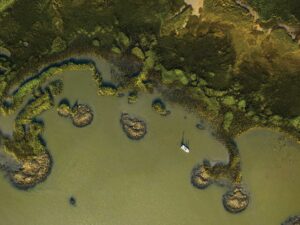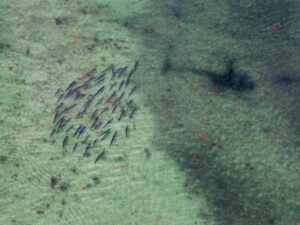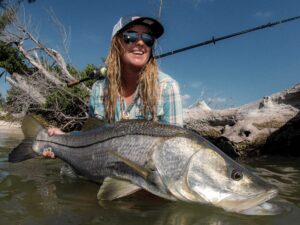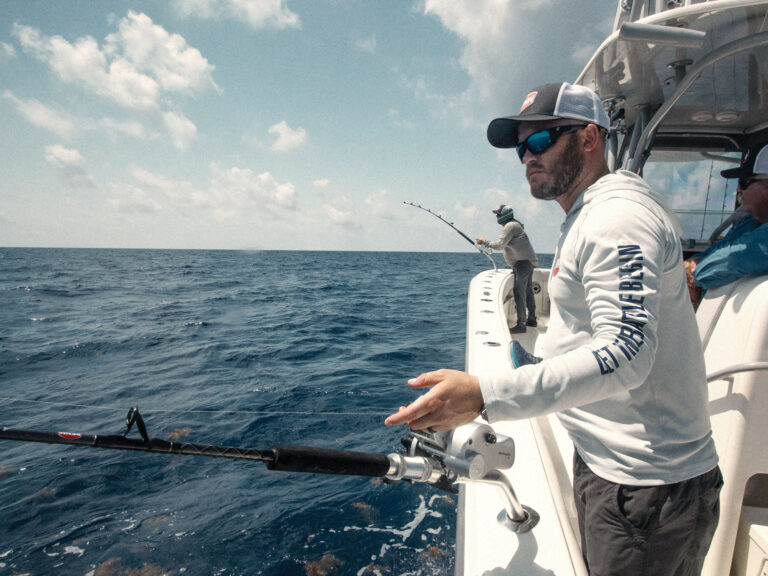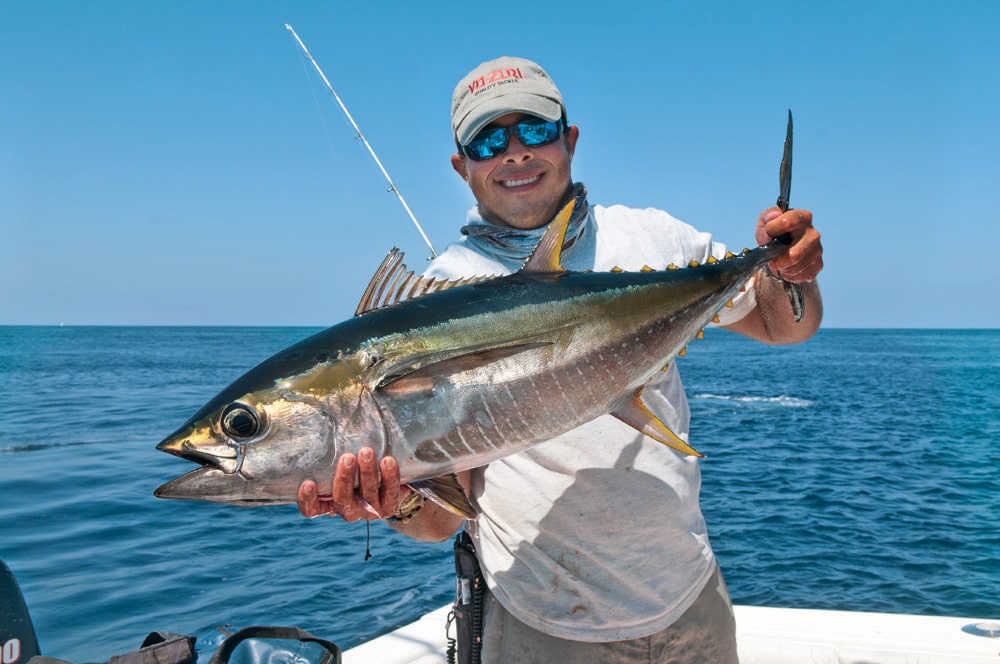
Porpoises rolled in every direction around the boat, as they had for hours, and once in a while, a yellowfin tuna would either roll with the porpoises, or leap from the water in pursuit of a baitfish. George Large, vice president and general manager of Yo-Zuri Lures, stood next to me at the bow as we both cast relentlessly, sweat pouring off each of us. We were fishing out of the Islas Secas Resort in Panama with our good friend Carter Andrews, and the tuna were thick, traveling with schools of spinner porpoises. Seeing those porpoises and the attendant tuna that swim with them makes your pulse pound as the adrenaline flows, and somehow it doesn’t seem unreasonable to make 200 casts or more a day in the tropical heat.
“Look at that, man,” Andrews said from the tower. “That’s solid tuna in front of the boat.” Large and I both acknowledged that fact and reminded him that we had been casting into the fish all day, with periodic success, but somehow the large fish we sought had eluded us to this point. We had each caught several nice yellowfin, the largest of which probably pushed 70 pounds, but we knew bigger ones were out there — much bigger ones. We had seen them.
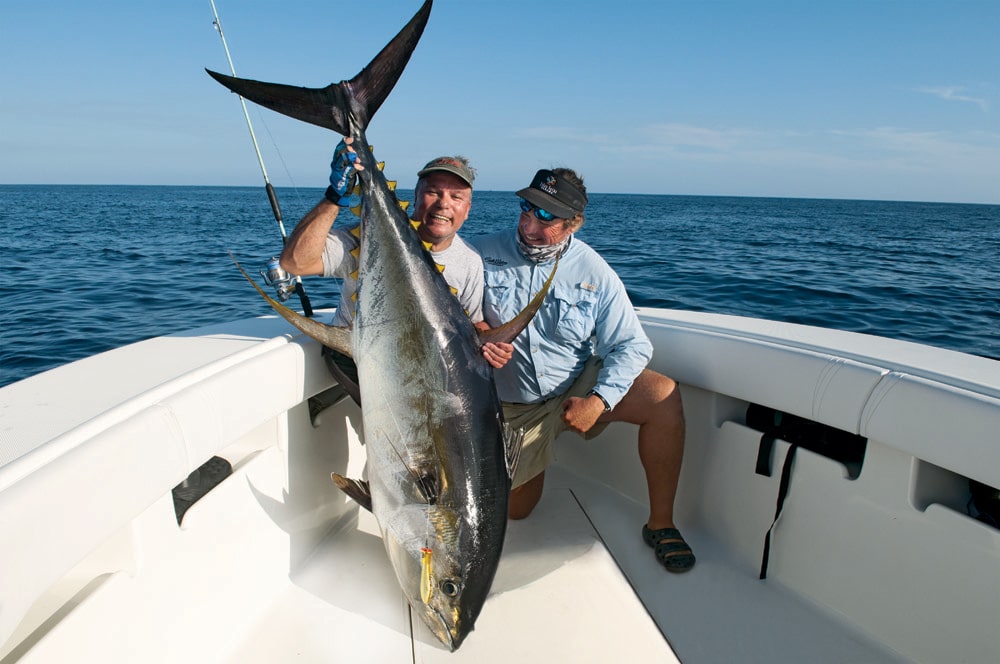
Big Bite
We were fishing near the famed Hannibal Bank close to Isla Montuosa when we ran across a smaller school of porpoises, and several large tuna rolled with the school simultaneously. “There they are, 2 o’clock!” Andrews hollered. Large was on the right side of the bow, and he let fly a long cast. His popper hit the water, and after only two pops on the retrieve, a huge tuna boiled on the lure. The yellowfin lay on its side on the surface for a few long seconds and thrashed the water in a furious frenzy, but when it finally sounded, it left in a hurry, taking lots of braided line with it.
Large is an expert angler, and he had hooked the fish on stout spinning tackle. He strapped himself into the stand-up gear and went to work, and twice the big tuna almost spooled him, but each time he persevered and gained line back foot by foot. Line came more steadily after some time, and an hour and 45 minutes after the bite, we saw color below the boat. After a few more strokes, the big fish lay just under the surface. Andrews’ mate, Juan Andres Spragge, sank a large gaff in its shoulder, and he and I hauled the fish over the gunwale in one motion. Large was one exhausted — yet exhilarated — angler. Later that night at the dock, the big yellowfin tipped a digital scale at 207.5 pounds.
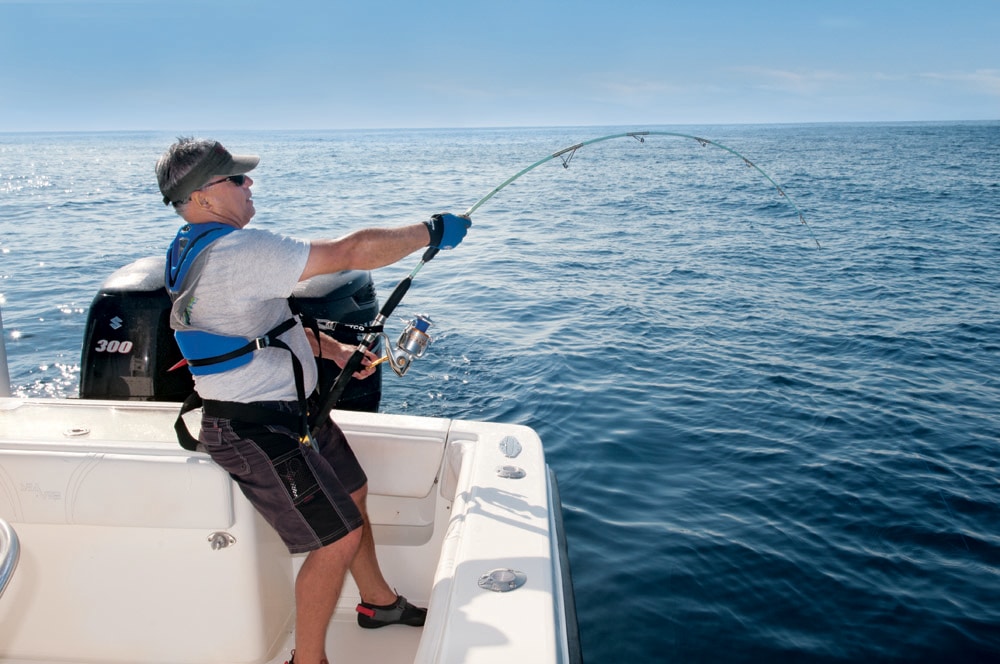
Numbers Game
Catching big tuna on casting gear is a numbers game. You have to cast a lot, and be fully prepared for long and brutal fights when you do hook up. Carter Andrews has become one of the world’s leading experts at this style of fishing during his tenure as Islas Secas’ director of fishing, so we asked him to share some thoughts about landing the fish of a lifetime on spinning gear.
“We are using 65-pound braid,” Andrews says. “It’s heavy enough to fight these monsters with maximum pressure but still small-enough diameter to maximize the cast. Heavier braid, 80- to 100-pound, just does not cast the same. The leader and double line needs to be at least six feet long. We have lost fish after a long fight when the main line chafed from the tuna’s tail. Leaders are a minimum of 100-pound-test fluorocarbon. A huge tuna will inhale even the biggest lure, then all you have is leader coming from its mouth, and a 250-pound yellowfin has substantial teeth.”
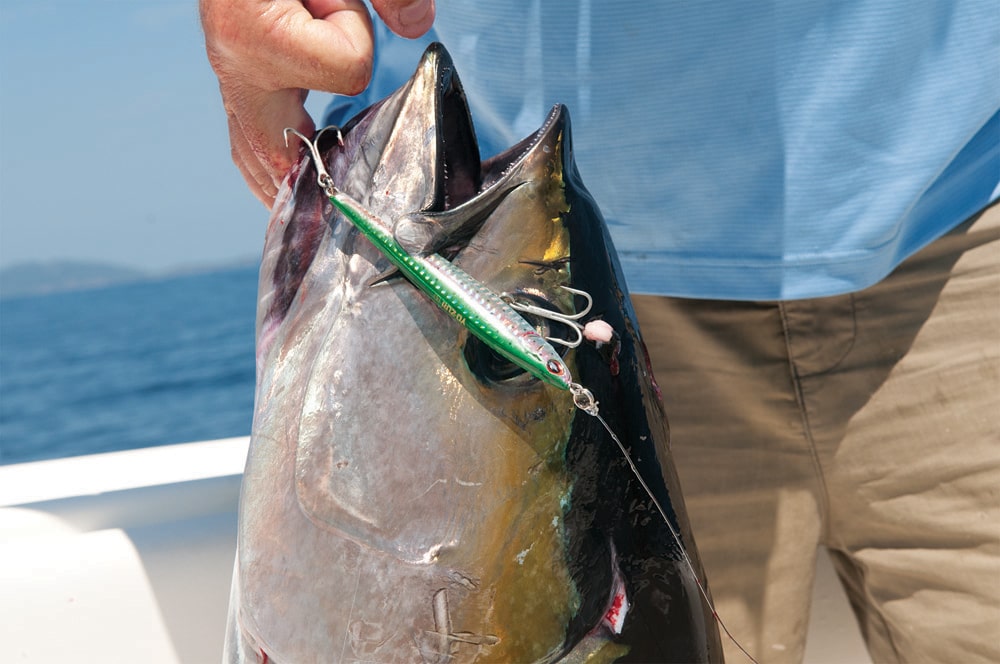
The yellowfin will eat both surface baits and subsurface lures like metal jigs and swimming baits, but it’s extra fun to fish poppers because it attracts a surface strike. “I fish Yo-Zuri, Ocean Tackle International and Sebile lures, both poppers and swimmers,” Andrews says. “There are days they will not eat a popper but will still crush a swimming lure like the Yo-Zuri Slider or the Sebile Stick Shadd.”
Andrews and his crew use Shimano tackle. “The Stella 18000SW has the fast retrieve that provokes strikes, and the 20000SW is geared lower for fighting,” he says. “Both have extreme drag capability for long runs. I use the Shimano Terez 100-pound popping rod. It has plenty of action for casting but offers lots of backbone too for bringing big fish up from deep water.”
Get in Position
Positioning the boat correctly becomes crucial when chasing the tuna schools. Sometimes the fish are finicky and move constantly, but other times, they go into a feeding frenzy on nearby bait. Patience is key. “When it is a full-on baitball with nothing but white water, keep the boat far enough away so the bait does not come to the boat for refuge,” Andrews says. “Don’t cast in the middle of the boil. You will get bit, but you’ll get cut off. Cast to the outside of the boil; you will still get bit, and hope the fish runs away from the boil and not straight into it.”
A different strategy comes into play when working the porpoise schools. “First and foremost, don’t run them over,” Andrews says. “I run a big circle around the fish and position the boat in front of the school, with the sun at my back when possible. Then I move in slowly from the sides, scanning the water for fish. Sometimes there is an occasional fish blowing up; other times slow rollers dimple the surface. Many times you will see nothing.”
Birds diving around porpoise schools are a dead giveaway as to the presence of fish, but it’s not always the large schools that offer the best shot at a hookup, as was the case with the big fish caught by George Large. “Some of my best fish have come from a small spot with maybe a dozen porpoises and just a couple of birds,” Andrews says. “I have hooked monsters in that scenario. There might not be lot of fish there — just a couple of big ones. Keep your distance and fire a cast 50 feet in front of the porpoises.
“On the retrieve, I like the reaction bite, and speed triggers that,” Andrews continues. “Hold the rod tip high, reel fast and make little twitches of the tip — they’ll blast it. If we are not getting the bite, I usually change the lure size. I do not focus on the color as much as I do on size. Another technique that works sometimes is taking a big cup-faced popper, cast it out and let it sit; then give it a big sweeping pop and let it sit again for three to five seconds. I have seen them explode on that, and when they do, hang on!”
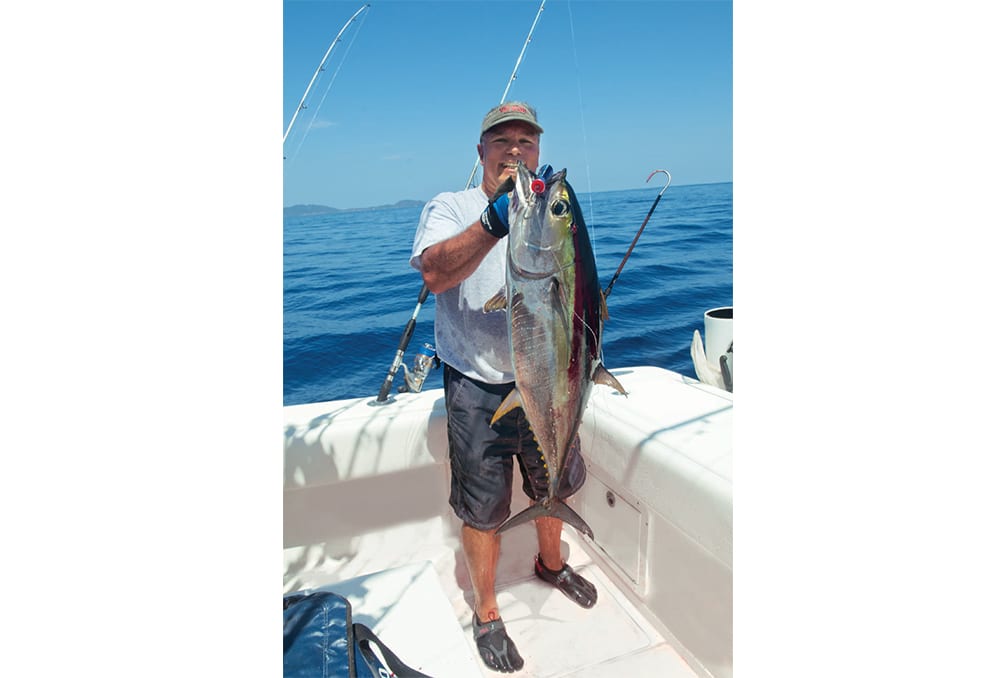
Battling Giants
“When you get bit by a giant, let it go. Don’t try to slow it down,” Andrews adds. “Let it do all the running it wants. Use the boat to try to keep pace so you don’t lose all your line. Don’t let up. When you are resting, it is resting, but good technique will whip the fish faster than strength every time.” A good harness system and fighting belt help. “We use the Black Magic XX-Wide as the plate,” Andrews says. “A harness also helps for back support and leaning on the fish. We have a small strap that we wrap around the spinning rod and clip to the harness.”
If you want to catch a large yellowfin on casting gear, there’s no better place than Panama. It’s an intense experience, from the bite to the endgame. “You might have caught a 200- or 250-pound yellowfin on a trolling rod, fishing a Tiagra 50-wide,” Andrews explains, “but that is nothing like this.”
Yellowfin Haven
The Gulf of Chiriqui lies off Panama’s Pacific coast on the western side of the isthmus, and the fertile waters offshore of the Gulf hold numerous game species. The famed Hannibal Bank is found here, as are Islas Coiba and Montuosa, all well-known fishing hot spots. The area is renowned for its population of black marlin, but it has gained an equally impressive reputation for producing many yellowfin tuna over 200 pounds and a few over 300.
What: Large yellowfin tuna on casting gear
When: January through May


